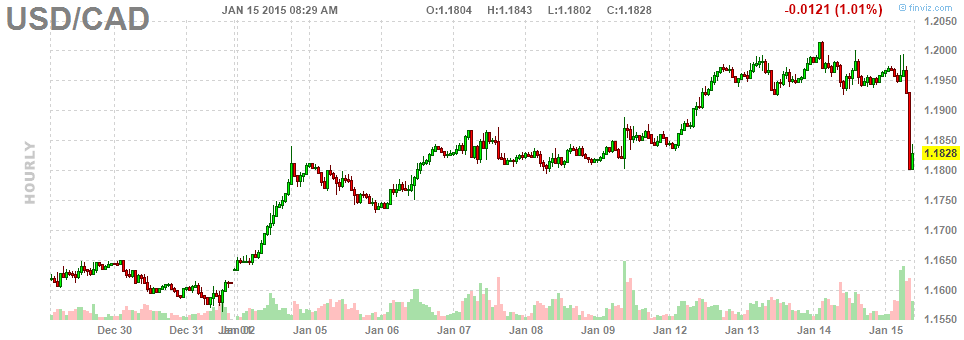Currency
Yesterday’s move by the Swiss National Bank was totally unexpected and brutal in it’s consequences. Removing the peg from the EURCHF caused the Swissie to rally 40% immediately causing stops to be triggered. Major FX markets moving this much in a single day is unheard of and the gap action meant that losing positions couldn’t be closed out anywhere close to their stop loss triggers. The nature of investing/trading today means many companies leveraging up their investment (borrowing more money to buy more) to maximize their profits and outperform their benchmark. The idea being to turn a 0.25% gain into a 0.5-1% gain, or even more for highly leveraged funds. But if you’re starting point is a 30% loss…..well you get the picture. Over the next few days we’ll be hearing lots of news about funds/trading houses closing their doors for good due to their losses incurred yesterday on this one way bet that suddenly surged the wrong way.
Elsewhere, the Loonie has had little trouble breaching the $1.20 level. We had a nice pop in oil earlier this week which didn’t do much for the Loonie, although yesterday’s extraordinary events in Europe did see 1.1810 print very briefly, but with oil firmly back below $50 the Loonie is along for the ride. It does seem like the path of least resistance remains for higher USDCAD.



The extreme support for the Swiss against the dollar lies at the 80-81 level. Resistance forms now at the 88-90 area followed by 93. The extreme collapse was due to the tremendous losses incurred by the central bank and the complacency among traders, including hedge funds, who basically just follow the crowd.
You have to realize that many of these houses are trend followers who really do read way too much into central banks. The Swiss were putting orders in the market constantly to hold the peg. Billion lot orders were becoming a daily routine and when hit, they kept it up. The cost was becoming outrageous. Nevertheless, the Swiss were left with little choice as capital is trying to flee Euroland.
….also from Martin:
The Coming Mortgage Panic Set-Off By Swiss
Gold – The January Pop – On Schedule?

In a dramatic move the SNB abandoned the CHF peg to the EUR which saw the CHF appreciate by as much as 38% versus the EUR. With market speculation rife about a move to full blown quantitative easing by the ECB next week, the SNB may have acted so as to limit its need to buy EUR to defend the peg if the ECB did resort to additional monetary stimulus.
CAD strengthened from just below 1.20 towards the low 1.180 versus the USD . Currently at 1.1910 ; The move in CAD was helped by a rebound in crude with WTI ( FEB) up nearly 2.5% today at it’s peak. Whilst oil enjoyed a 6% pop yesterday all the Loonie could manage was a bit of a sideways shuffle which is not an encouraging sign. With oil now trading lower USDCAD is back above 1.19 and that 1.20 level and beyond is looking very attainable ; Support in USD.CAD is down at 1.1790 and resistance up at 1.2008.

For the last 48 hours USDCAD has been stuck in a pretty tight range chopping around the 1.1950 level and it feels like it’s just preparing itself for a charge through the psychologically important 1.20 barrier. So when it does bust through where is the next stop on the line? Clearly right now price action is determined by where oil is going so let’s look at long term support for wti. Only yesterday we had the UAE energy minister confirming that there will be no change in OPEC policy and no reduction in production, and so the falling knife that is the price of oil has further to go. Looking at the weekly chart of oil going back 15 years we are now getting close to the mid 30 lows seen during the financial crisis of 2008, which would be a natural level of support. So what does a $35 barrel of oil mean for the Loonie……..the current correlation would suggest a level of 1.22, which also happens to be a longer term resistance point.
Weekly Oil going back 15 years

Throughout my years on Wall Street and to this day, one question has always bothered me. I have never got a good explanation as to why the price of crude oil and the strength of the USD move in negative correlation. I’ve heard many different arguments but none are foolproof. I’ve even read that there is no causality in the relationship, that’s it’s all in our minds.
The main argument seems to be that as most commodities, including crude, have historically been priced in dollars, if the dollar strengthens, it takes less dollars to buy a barrel of crude, and vice versa, hence the reverse correlation. This seems to make sense, but is it just the dollar that drives the relationship? Can an increase or decrease in the price of oil be the determining factor as well? Many explanations have focused on the economic impact of interest rate changes and the possible associated demand implications they would bring. But what about supply? What if, like today, the supply of oil is plentiful and growing due to geopolitical changes in the production of crude? Will this drive a stronger dollar as well? Or is it the stronger dollar that has pushed the oil price lower?
For supply and demand related solutions to this investment quandary, wouldn’t there be a lag time to a direct causality? For example, if interest rates rise, wouldn’t it take a while for this to hit the demand side of the equation and impact the oil price? Historically the correlation has been much more immediate. Is it the case that the market is just looking forward to these economic consequences?
Another wrench could be thrown into the discussion. Now that many countries are trying to remove the USD as the commodity trading currency and replace it with their own domestic currencies, how will this impact the USD/crude relationship? Will the yuan and/or the euro or ruble begin to act in the same manner in conjunction with commodity prices? This remains to be seen.
As we have seen recently with the severe drop in the price of crude, the dollar has strengthened accordingly, confirming the historic negative correlation we have been discussing. The question in my mind is, with all of the geopolitical changes in the production of crude, will this relationship exist in the future? One can foresee a situation where the United States will not import much oil at all in a decade or so, maybe sooner. Will oil and the dollar still react in the same way then?
Perhaps we should limit the conversation to a very short-term horizon. Oil is at a multi-year low. The dollar is at a multi-year high. Demand for crude is falling due to an economic slowdown outside the United States. The supply of crude is at very high levels with no end in sight as American fracking keeps pumping and OPEC refuses to cut production to shore up the price. What will happen when this dynamic changes. What if 500 rigs come off line like T. Boone Pickens forecasts? What if Saudi Arabia decides to help out its OPEC friends and cut production? What if global economic activity shows signs of life and the price of crude starts to rise?
The high probability is that the historical negative correlation between the price of oil and the strength of the USD will remain in place, regardless of whatever reason you attribute to this causality. That means the USD will weaken. It’s a matter of when, not if. Which will be good news for the Loonie which has been firmly tied to that barrel of oil for the last 6 months.
Loonie and Oil, sinking together
Click & Scroll for Larger Image
L Todd Wood
L Todd Wood is a former emerging market debt trader with 18 years of Wall Street and international experience. He is a contributor to Fox Business, Newsmax TV, and others as well as Agility Forex.
















